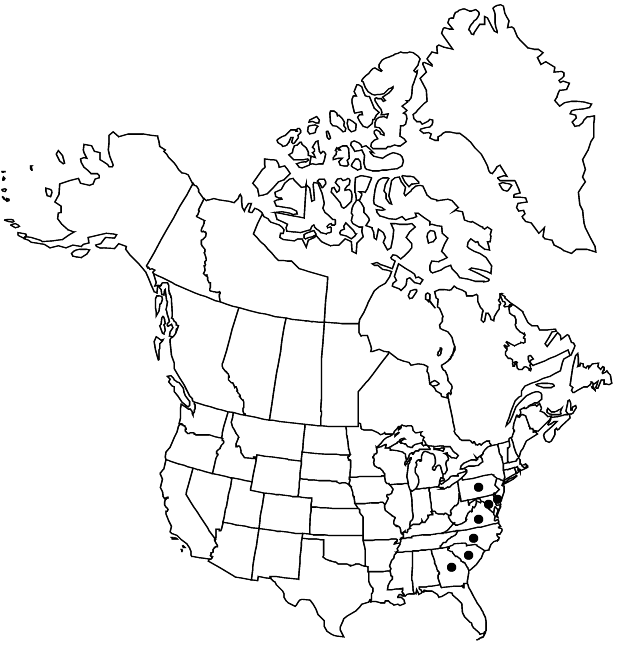Rhododendron atlanticum
in E. H. Wilson and A. J. Rehder, Monogr. Azaleas, 147. 1921 ,.
Shrubs, to 0.5–1 m, very strongly rhizomatous. Stems: bark ± smooth, not shredding; twigs scattered, multicellular eglandular-hairy (hairs unbranched) and/or stipitate-glandular-hairy, otherwise glabrous or, sometimes, sparsely unicellular-hairy. Leaves deciduous; petiole multicellular eglandular- and/or stipitate-glandular-hairy, sometimes also unicellular-hairy; blade ovate to obovate, 2–5.5(–6.5) × 0.8–2(–3) cm, thin, membranous to chartaceous, margins entire, plane, ciliate, eglandular-hairy, apex acute to obtuse, often mucronate, abaxial surface glabrous or, rarely, sparsely scattered eglandular-hairy, sometimes sparsely (rarely densely) unicellular-hairy, adaxial surface (lustrous to dull), glabrous or sparsely scattered stipitate-glandular-hairy, sometimes also sparsely unicellular-hairy. Floral bud scales glabrous or densely unicellular-hairy abaxially, margins usually unicellular-ciliate. Inflorescences 4–13-flowered; bracts similar to bud scales. Pedicels 4–15(–20) mm, eglandular- and/or stipitate-glandular-hairy, otherwise glabrous or sparsely (rarely moderately) unicellular-hairy. Flowers opening before or with leaves, erect to horizontal, usually very fragrant and/or nearly mephitic-scented; calyx lobes 0.7–5.5(–10) mm, marginal and scattered stipitate-glandular- or, less commonly, eglandular-hairy, sometimes also unicellular-hairy; corolla white, usually flushed pink or rose (especially on tube), without blotch on upper lobe, funnelform, 23–58 mm, scattered, usually conspicuous, multicellular stipitate-glandular-hairy (hairs forming prominent band along middle of each lobe), otherwise glabrous or, sometimes, sparsely unicellular-hairy on outer surface, petals connate, lobes 8–24 mm, tube rather gradually expanded into lobes, 16–35 mm (equaling or longer than lobes); stamens 5, much exserted, ± unequal, 32–63 mm. Capsules borne on erect pedicels, 10–24 × 4–8 mm, usually densely stipitate-glandular-hairy, otherwise glabrous or densely unicellular-hairy. Seeds without distinct tails, flattened portion of testa well developed at each end; testa expanded, dorsiventrally flattened, ± loose. 2n = 26.
Phenology: Flowering spring.
Habitat: Moist pine flatwoods and savannas, sometimes in drier pine and/or oak forests, primarily in fire-maintained communities of the Atlantic coastal plain
Elevation: 0-200 m
Distribution

Del., Ga., Md., N.C., Pa., S.C., Va.
Discussion
Varieties and forms have been described within Rhododendron atlanticum (see E. H. Wilson and A. J. Rehder 1921; K. A. Kron 1993). Hybrids between it and R. canescens and R. periclymenoides are known. Rhododendron atlanticum is easily confused with the sympatric R. viscosum, which generally is taller, less rhizomatous, hairier, larger-leaved, and later-flowering (i.e., flowers appear after the leaves have expanded).
Selected References
None.